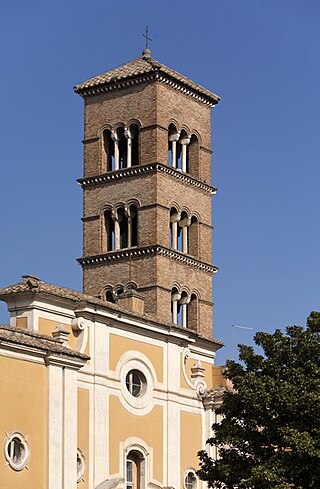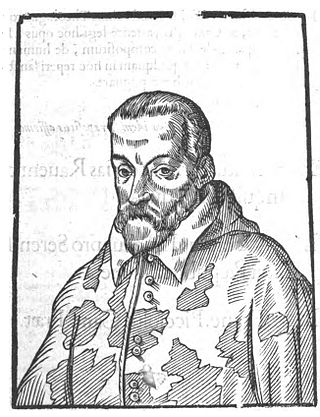Related Research Articles

Pope Pius IV, born Giovanni Angelo Medici, was head of the Catholic Church and ruler of the Papal States from 25 December 1559 to his death, in December 1565. Born in Milan, his family considered itself a branch of the House of Medici and used the same coat of arms. Although modern historians have found no proof of this connection, the Medici of Florence recognized the claims of the Medici of Milan in the early 16th century.

Girolamo Muziano or Mutiani, was an Italian painter, one of the most prominent artists active in Rome in the mid-to-late sixteenth century.

Emilio de' Cavalieri, or Emilio dei Cavalieri, the spellings "del" and "Cavaliere" are contemporary typographical errors, was an Italian composer, producer, organist, diplomat, choreographer and dancer at the end of the Renaissance era. His work, along with that of other composers active in Rome, Florence and Venice, was critical in defining the beginning of the musical Baroque era. A member of the Roman School of composers, he was an influential early composer of monody, and wrote what is usually considered to be the first oratorio.

Sant'Eusebio is a titular church in Rome, devoted to Saint Eusebius of Rome, a 4th-century martyr, and built in the Esquilino rione. One of the oldest churches in Rome, it is a titular church and the station church for the Friday after the fourth Sunday in Lent.

The Basilica of San Sisto Vecchio is one of the over sixty minor basilicas among the churches of Rome, and a titular church since 600 AD. As such, it is connected to the title of a Cardinal priest, currently Antoine Kambanda.

The Roman Catholic Suburbicarian Diocese of Ostia is an ecclesiastical territory located within the Metropolitan City of Rome in Italy. It is one of the seven suburbicarian dioceses. The incumbent Bishop is cardinal Giovanni Battista Re. Since 1150, its bishop has been the Dean of the College of Cardinals, Its Cathedral is Basilica di Sant'Aurea.

The Roman Catholic Archdiocese of Naples is a Roman Catholic Archdiocese in southern Italy, the see being in Naples. A Christian community was founded there in the 1st century AD and the diocese of Naples was raised to the level of an Archdiocese in the 10th century. Two Archbishops of Naples have been elected Pope, Paul IV and Innocent XII.

The Diocese of Sabina–Poggio Mirteto is a suburbicarian see of the Holy Roman Church and a diocese of the Catholic Church in Italy in the Roman province of the Pope.

The Roman Catholic Suburbicarian Diocese of Palestrina is a Roman Catholic suburbicarian diocese centered on the comune of Palestrina in Italy.

The Diocese of Frascati is a suburbicarian see of the Holy Roman Church and a diocese of the Catholic Church in Italy, based at Frascati, near Rome. The bishop of Frascati is a Cardinal Bishop; from the Latin name of the area, the bishop has also been called Bishop of Tusculum. Tusculum was destroyed in 1191. The bishopric moved from Tusculum to Frascati, a nearby town which is first mentioned in the pontificate of Pope Leo IV. Until 1962, the Cardinal-Bishop was concurrently the diocesan bishop of the see. Pope John XXIII removed the Cardinal Bishops from any actual responsibility in their suburbicarian dioceses and made the title purely honorific.

The Roman Catholic Suburbicarian Diocese of Velletri–Segni is one of the suburbicarian dioceses, Catholic dioceses in Italy close to Rome with a special status and a cardinal bishop, the bishop of Velletri–Segni. Historically, the see of Velletri was combined with the see of Ostia from 1060 to 1914.

Luigi d'Este was an Italian Catholic cardinal, the second son of the five children of Ercole II d'Este, Duke of Modena and Ferrara, and Renée, daughter of Louis XII of France.

Giulio Cesare Sacchetti was an Italian Catholic Cardinal and was twice included in the French Court's list of acceptable candidates for the Papacy, in 1644 and 1655.

Mario Theodoli was an Italian Catholic Cardinal.
Laudivio Zacchia was an Italian Catholic cardinal.
Gianantonio Capizucchi was an Italian Roman Catholic cardinal and bishop.
Francesco Crasso (1500–1566) was an Italian Roman Catholic cardinal.

Marcello Santacroce was a Roman Catholic cardinal who served as Bishop of Tivoli (1652–1674).

Mario Alberizzi (1609–1680) was a Roman Catholic prelate who served as Cardinal Priest of San Giovanni a Porta Latina (1675–1680), Archbishop of Tivoli (1676–1679), and Apostolic Nuncio to Austria (1671–1675).
Francesco Boncompagni was an Italian Cardinal, made cardinal in 1621.